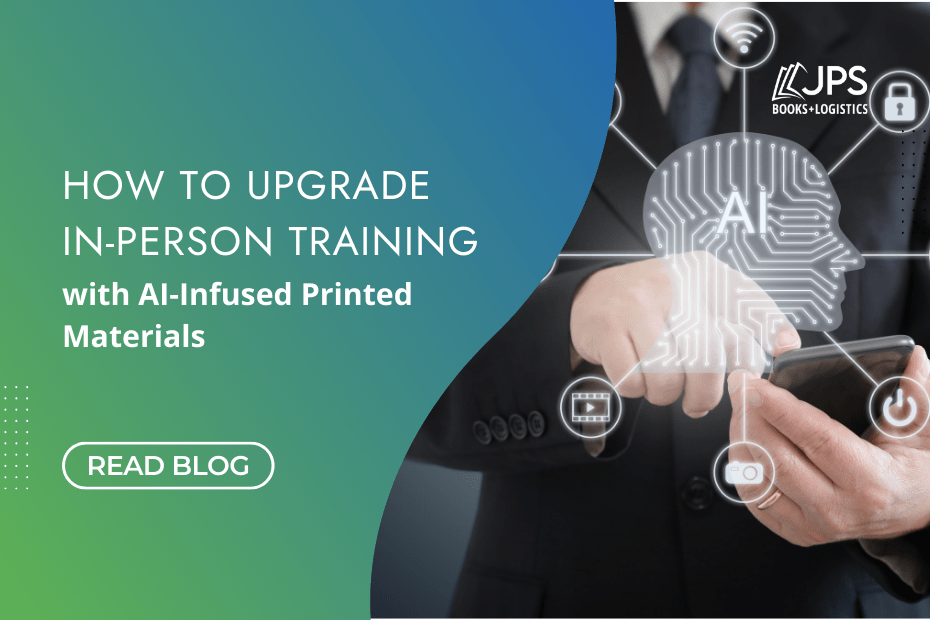Artificial intelligence (AI) is transforming industries, and training and professional development are no exceptions.
AI is frequently linked with eLearning, and blending it with in-person training can majorly improve classroom experiences. Let’s talk about how, by combining AI technology with traditional printed materials, we can create a more engaging and effective learning environment!
The Evergreen Value of In-Person Training
Over the last ten or so years, the eLearning market has exploded and is projected to grow at a compound annual growth rate of 20% through 2030 (Research and Markets, 2022).
Despite this surge, in-person training remains irreplaceable for a few scenarios. Hands-on practice, real-world simulations, and collaborative discussions thrive in face-to-face settings. These interactions foster what experts call “spontaneous conversations and immediate feedback”, and they’re crucial for higher knowledge retention.
AI: A Catalyst for Dynamic In-Person Training
While eLearning platforms utilize AI to replicate classroom dynamics through real-time feedback and fun, interactive features, this technology also has big implications for in-person training.
AI can assess each learner’s unique style and performance, allowing for real-time content adaptation and personalized support.
Traditional classroom training often follows a set curriculum, with instructors adjusting their methods based on group responses. However, printed training materials tend to lack the flexibility of digital resources. Here, AI has space to make a significant impact.
Imagine a classroom where AI-powered tools seamlessly integrate with printed materials, boosting learning outcomes and knowledge retention. Printed textbooks and manuals introduce complex topics, but when paired with AI-driven interactivity, they transform the learning experience!
Unlocking Potential: Five Strategies to Compliment Printed Course Materials with AI
Several AI tools powered by natural language processing can revolutionize how learners engage with printed materials. These tools can analyze text, generate supplementary resources, personalize content, and provide real-time feedback—all within the classroom context.
1. AI-Powered Interactive Assessments
Incorporate QR codes in your course materials to direct learners to AI-driven assessment tools. These platforms offer immediate evaluations, personalized feedback, and tailored content recommendations based on individual performance, creating a dynamic and customized learning experience.
2. Augmented Reality (AR) Enhancements
Integrate augmented reality into your printed materials by incorporating AI. How, you ask? Learners can use smartphones or tablets to scan pages, triggering interactive 3D models, simulations, or additional resources, enriching their understanding and engagement with the material!
3. Language Translation and Accessibility
AI can bridge language gaps and enhance accessibility. QR codes can link to AI-powered translation tools, enabling learners to access course materials in their preferred languages. Additionally, AI can provide audio descriptions to make printed materials more inclusive, opening the door to students with diverse learning needs.
4. Personalized Study Guides
Utilize AI technology to create personalized study guides! By scanning QR codes, learners can receive customized study plans tailored to their progress and learning styles. These guides can suggest reading materials, practice exercises, and milestones to help achieve their learning goals.
5. Dynamic Quizzes and Polls
Transform traditional assessments with QR codes leading to interactive quizzes and polls. AI-powered tools can instantly grade responses and provide explanations, turning assessments into valuable learning opportunities, rather than boring, predictable evaluations.
Before You Go…
The future of in-person training is bright, and AI is leading the way!
Ready to ride the wave of technology and printed learning materials? Let JPS help! Our amazing in-house team is ready to help equip you with the resources you need to usher in your best semester yet.
References
Garrison, D. R., & Vaughan, N. D. (2008). Blended Learning in Higher Education: Framework, Principles, and Guidelines. Jossey-Bass.


